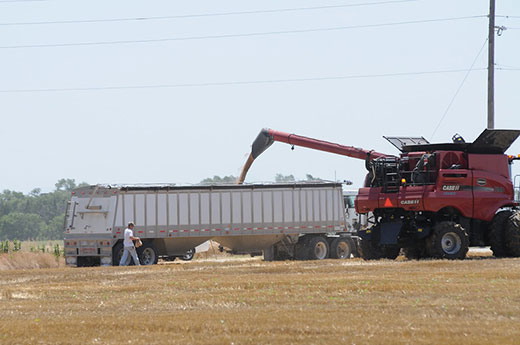
Net farm income for Kansas grain farms increased by 39% in 2021, though not all farms saw a profit.
Net farm income fluctuating in Kansas
K-State agricultural economists forecast changes in income between 2021 and 2022
Jan. 17, 2022
MANHATTAN, Kan. -- When making personal or business decisions, it is important to be as informed as possible about the expected costs for the year ahead and sometimes that involves consulting with an expert. In agriculture, many farmers turn to economists.
Working to help farmers make informed decisions, K-State agricultural economists have released their preliminary estimates of the 2021 Kansas net farm income and forecasts for 2022.
“For 2021 we expect the net farm income for Kansas grain farms to be around $261,000, which is a 39% increase from 2020,” said Gregg Ibendahl, associate professor of agricultural economics.
Listen to an interview by Eric Atkinson with Gregg Ibendahl on the weekday radio podcast, Agriculture Today
For a variety of reasons, not all farms will experience a profit and Ibendahl expects that 10% of farms will see negative net income for 2021.
In their estimates, Ibendahl and his colleagues looked at seven areas: yields, prices, crop acres, expenses, crop insurance, government payments from the farm bill and ad hoc government payments. He said each area was projected to the farm level to estimate net farm income for 588 grain farms in the Kansas Farm Management Association database.
“On the expense-side, fertilizer has increased dramatically,” Ibendahl said. Other factors influencing the projections are higher inflation, supply chain issues and the volatility of grain prices, yields and inputs.
Regarding fertilizer expenses, Ibendahl said many farmers may have bought what they needed for 2021 ahead of the price increase and therefore it may impact their 2022 profits more significantly.
Looking to 2022, Ibendahl is projecting a drop in net farm income because of the increase in input costs and the likelihood of low government payments.
“Everything in 2022 is going to be at least 5-10% higher for input costs because of inflation,” Ibendahl said. In respect to diesel and other fuels, the costs are expected to show a 30% increase in 2021 and an additional 30% increase in 2022.
“Fuel and oil prices are tied to fertilizer prices to some degree,” he said.
He added: “Seed costs are forecast to be 5% higher in 2021, but rise an additional 20% in 2022.” Pesticide expenses are increasing as well.
The projection for 2022 appears more bearish.
“The net farm income is forecast to fall 65% in 2022 to $90,000,” Ibendahl said. He added that this number will be influenced by rainfall and the timing of the fertilizer purchase, among other factors.
“Most farms should still be profitable at levels last seen in 2018; the major worry is going into 2022 that 30% of Kansas grain farms could have a negative net farm income,” he said.
To view the full report, go to agmanager.info.

